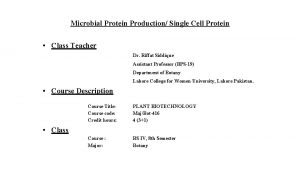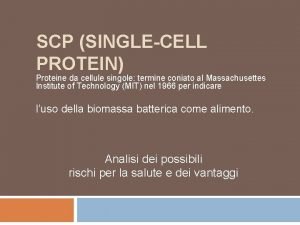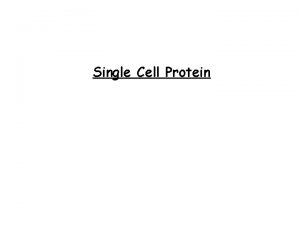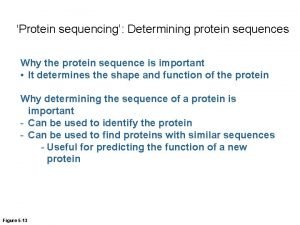SINGLE CELL PROTEIN The term single cell protein


















- Slides: 18

SINGLE CELL PROTEIN The term single cell protein (SCP) refers to dead, dry cells of micro-organisms such as yeast, bacteria, fungi and algae which grow on different carbon sources and provide important amino acids for human beings. The name "single cell protein" was used for the first time, twenty years ago by the M. I. T. professor Carol Wilson to give a better image than "microbial protein

Proteins are important nutrient in diet on the basis of amino acids Essential amino acids Diseases due to deficiency 1. Leucine, 2. Isoleucine 3. Lycine Kwashiorker fatal disease in Japan 4. Methionine Marasmus disease in Africa and Asia 5. Phenylalanine 6. Threonine 7. Tryptophan 8. Valine, Cystein, Arginine, Histidine Grains, Plants, Animals (beef, Egg, Milk) is the source to get these aminoacids but due to high need of population in this world , there is deficiency of these aminoacids

Micro-organisms producing Single cell protein • Algae: Chlorella, scenedesmus, Laminaria, Spirulina • Fungi: Fusarium, Aspergillus, Penicillium, Rhizopus, Polyporus and Trichoderma, Sclerotium rolfsii • Bacteria: Lactobacillus, fermentas, Nocardia, alcaligensviscosus, E. coli, Rhodopseudomonas capsulata • yeasts : Sacoryzaecharomyces cerevisiae, Candida utilis=Torulopsis and Geotrichum candidum (=Oidium lactis)),

SCP from Algae • • Protein content of algae ranges from 40 -60% Lysine and threonine are rich in algae No methionine in algae Being autotroph algae is major source of vit c and Vit b complex

SCP from Bacteria • Amount of protein content is very high ranging from 78 -87% • Lysine , threonine, tryptophan, methionine amino acids are present • Bacteria cells are mostly used for SCP due to rapid growth and ability to grow on hydro carbons • Also source of various vitamins

SCP from Fungi • Protein contents are 19 -47% • Rich in methionine • Riboflavin and Vitamin B-12 present in good amount in fungi • They can grow in crude raw material • Easily handles for extraction of protein

SCP from Yeast • • • Amount of protein is 45 -55% Most easily digestible protein All essential aminoacids except methionine Riboflavin and Pentathenic acid vitamins No adverse effect on human and animal systems

Properties of SCP One of the main advantages of SCP compared to other types of protein is the small doubling time of cells (td) as shown in Table 1. Mass doubling time (S)

Due to this property, the productivity of protein production form microorganisms is greater than that of traditional proteins Efficiency of protein production of several protein sources in 24 hours

Nutritional Value of SCP For the assessment of the nutritional value of SCP, factors such as nutrient composition, amino acid profile, vitamin and nucleic acid content as well as palatability, allergies and gastrointestinal effects should be taken into consideration. Also long term feeding trials should be undertaken for toxicological effects and carcinogenesis. Average composition of the main groups of micro-organisms (% dry weight)

Bacterial protein is similar to fish protein, yeast's protein resembles soya and the fungi protein is somewhat lower than the yeast's. Of course microbiological proteins are deficient in the sulphur amino acids cysteine and methionine and require supplementation, while they exhibit better levels of lysine Essential amino acid content of the cell protein in comparison with several reference proteins (grams of amino acid per 100 grams of protein)

The vitamins of micro-organisms are primarily of the B type, B 12 occurs mostly in bacteria, while vitamin A is usually found in algae. Table shows the vitamin content of various food micro-organisms. Vitamin content of various food micro-organisms (mg/100 g dry weight) (15

SCP Production Process • Single cell proteins develop when microbes ferment waste materials (including wood, straw, cannery and food processing wastes, residues from alcohol production, hydrocarbons, or human and animal excreta). • The problem with extracting single cell proteins from the wastes is the dilution and cost. They are found in very low concentrations, usually less than 5%. Engineers have developed ways to increase the concentrations including centrifugation, flotation, precipitation, coagulation and filtration, or the use of semi-permeable membranes. • The single cell protein needs to be dehydrated to approximately 10% moisture content and/or acidified to aid in storage and prevent spoilage. The methods to increase the concentrations to adequate levels, and dewatering process require equipment that is expensive and not always suitable for small-scale operations. • It is economically prudent to feed the product locally and shortly after it is produced.

Advantages of Production of SCP over conventional protein sources are • 1. Microorganisms have a high rate of multiplication to hence rapid succession of generation (algae: 2 -6 hours, yeast: 1 -3 hours, bacteria: 0. 5 -2 hours) • 2. They can be easily genetically modified or controlled for varying the amino acid composition. • 3. A very high protein content 43 -85 % in the dry mass. • 4. They can utilize a broad spectrum of raw materials as carbon sources, which include even waste products. Thus they help in the removal of pollutants also. • • 5. Strains with high yield and good composition can be selected or produce relatively easily.

• 6. Microbial biomass production occurs in continuous cultures and the quality is consistent since the growth is independent of seasonal and climatic variations and need no land for cultivation • 7. A high solar energy conversion efficiency per unit area. • 8. Solar energy conversion efficiency can be maximized and yield can be enhanced by easy regulation of physical and nutritional factors. • 9. Algal culture can be done in space which is normally unused and so there is no need to compete for land. • 10. It can cause less pollution

There are five factors that impair the usefulness of SCP: Disadvantages of SCP non digestible cell wall (mainly algae); high nucleic acid content harmfull for animals and humans; Nucleic acid content should be less than 50 g/day for monogastric animals unacceptable coloration (mainly with algae); disagreeable flavour (part in algae and yeasts); cells should be killed before consumption. Bacterial endotoxins, mycotoxins Allergic reactions in human beings Ingestion of purine compounds arising from RNA breakdown, leads to increased plasma levels of uric acid, which can cause gout and kidney stones. Uric acid can be converted to allantoin, which is excreted in urine. Nucleic acid removal is not necessary from animal feeds but is from human foods. Thus SCP is treated with various methods in order to: • kill the cells; • improve the digestibility; • reduce the nucleic acid content. • • •

Selection of an appropriate microorganism for SCP production • The microorganism must be one that is edible and can serve as a feedstock for humans and/or livestock. • its culture must be technologically and economically feasible. • To satisfy the secondition: 1) the organisms must grow rapidly and vigorously; 2) culture of the organism should involve the use of relatively simple growth units and inexpensive nutrient sources (e. g. , commercial crop fertilisers); 3) ideally, the organism could be grown in open culture, or at least as an enrichment culture; and 4) because single-cell protein production is only marginally economically feasible, the least “permissible” condition is the need to culture the organism under sterile conditions, i. e. , as a completely pure culture.

SCP's Evaluation and Future Prospects • The development of SCP was really the beginning of biotechnology. Prior to this the industrial fermentation was mainly focused on antibiotics and other products which did not have to compete. • This was not the case with SCP which had to compete with similar products in the market. The development was brought up by the oil companies rather than the food companies, because they could take the risk of a highly costly product out with no real expected profit. They also had all the high technology required. • The efforts tried so far by adding dry SCP as a supplement to diets in order to solve the problems of the hungry in the Third World Countries, certainly have not given the expected results. Every new food which appears in the market should have not only high nutritive quality, but also satisfactory organoleptic supplementary element. • Today in most countries where market forces operate. SCP cannot compete with soya, alfalfa or fish meal. Mushroom production from lignocellulosics seems to be one economical and promising use for SCP. • For future success of SCP, first, food technology problems have to be solved in order to make it similar to familiar foods and second, the production should compare favourably with other protein sources.
 Single cell protein ppt
Single cell protein ppt Single cell protein
Single cell protein Channel vs carrier proteins
Channel vs carrier proteins Protein-protein docking
Protein-protein docking Short, medium and long term planning in education
Short, medium and long term planning in education Term-to-term rule
Term-to-term rule Long term memory vs short term memory
Long term memory vs short term memory Quadratic sequence
Quadratic sequence Long term hr planning
Long term hr planning Position-to-term
Position-to-term Difference between long term and short term liabilities
Difference between long term and short term liabilities Long term liabilities
Long term liabilities Maxterm notation
Maxterm notation Nth term rule
Nth term rule Term to term rule
Term to term rule Short term goals
Short term goals Research paper on financial planning and forecasting
Research paper on financial planning and forecasting Hát kết hợp bộ gõ cơ thể
Hát kết hợp bộ gõ cơ thể Slidetodoc
Slidetodoc


































